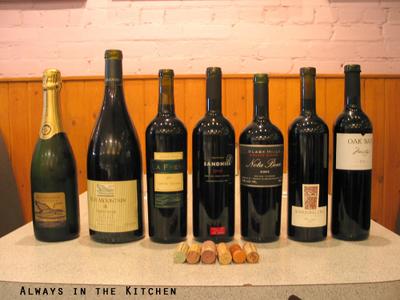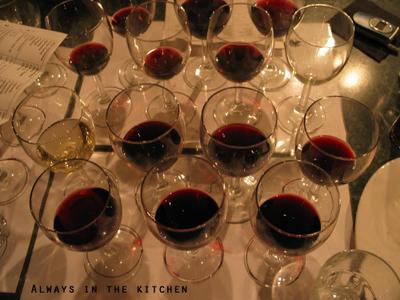The August wine tasting - BC Small Lots - was unexpectedly good. I don't know why I'm still amazed whenever I have good red wines from BC, but I still have this reflexive cringe from my very first (to my knowledge) BC red back in the late '80s - a Calona Vineyards Pinot Noir. I didn't know much about wine in general at the time, and I certainly didn't know anything about Pinot Noir, other than that it had a cool sounding name. You know, set yourself up with some film noir and a glass of Pinot Noir - it just sounded like it should be fancy and mysterious, and maybe a bit elitist. It should probably be wearing a beret. However, even in my utterly uneducated state, I disliked the wine intensely. It may have in fact delayed my interest in wine by several years.
How much has changed! While generally a little overpriced, some BC red wines can compete palate-to-palate with wines from Europe and beyond. This tasting consisted of seven BC wines that are produced in limited releases - one sparkling and six red. Many of these are not available in liquor stores, although you may have some luck in wine shops, or ordering from the vineyard directly.
 Photo Credit: D. Langtry
Photo Credit: D. Langtry
Whenever we have a sparkling, that's where we start first. It's poured last, and the tasters fall on it with a cry without waiting for their peer's glasses to be poured. nv Blue Mountain Brut is where we started, and it was widely agreed to be a pleasant wine. It had a sharp, crisp scent of apples on the nose, and a sort of Strongbow-like flavour of cider on the palate. There was simply nothing outstanding about it, and several tasters noted that they could buy a lot of good sparkling cider for the $22 price tag. Still, it's always nice to start with a sparkling wine, yes?
We moved on to another Blue Mountain, this time a magnum of the 2000 Reserve Pinot Noir Striped label. A previous tasting of the much sought-after Blue Mountain Pinot Noir (regular) revealed it to be disappointing, so we were keen to see how this one stacked up as it was both a) the reserve, and b) a magnum size (wine generally tastes better if it is stored in a larger bottle than the standard 750 ml). It was pretty enough, with a garnet red colour and a clear rim, and even the scent of chalk and rock wasn't off-putting - Pinot Noir can have some fairly funky odors. Unfortunately, the palate was equally rocky, and very thin-textured, with no fruit or pepper flavours at all. It seemed rather sour to me, and I moved on relatively quickly. $75 for the magnum - yikes!
Happily, I moved on the the LaFrenz 2002 Cabernet Sauvignon, from Naramata, at $27. Bloody and opaque, with just a faint hint of orange showing at the rim, the nose yielded very little. The palate however, was a musky combination of cherries and plums, with a faint acridity. It had good body - lots of body! - and it was generally concluded that a strong game meat would be ideal to stand up to the fierce flavours. Possibly something cooked with juniper berries...
The next wine was the 2002 Sandhill Syrah Small Lots - Phantom Creek at $30. This is not a Burrowing Owl Sandhill, by the way, but a very interesting boutique wine. It was the kind of dark opaque red that almost looks like a black hole - as though light would have trouble escaping its surface. The legs were thick, quick to form and fast moving. The nose was unusual, consisting solely of plums and salt-licorice. The palate was even more unusual, evoking the words "dark, bark, metal, rocks, licorice, and salt." Almost unanimously, tasters declared it "kind of weird" but many of us kept going back to our glass, sipping and frowning and sipping, and gradually confessing a sort of growing fondness for it.
We eventually put our glasses down and picked up the 2003 Oak Bay Meritage, at whopping $35. The composition of this wine was 40% Merlot, 30% Cabernet Sauvignon, 30% Cabernet Franc. It was a pretty, bright red with a cherry-pink rim, a fair amount of acidity and a little red fruit on the nose, and a sour-cherry flavour that was quite refreshing. The price tage makes this one a little too steep for what is essentially a fruit-and-cheese sipping red, or the second bottle at a dinner party, but it wasn't bad at all.
2002 Burrowing Owl Meritage, however was worth its $35, which is a relief to those of us already housing one in our wine cellars. The composition of this wine was 20% Merlot, 60% Cabernet Sauvignon, 20% Cabernet Franc. The wine is a dark ruby colour, opaque, and with good body. The nose is a little rocky, but the flavours were fruit, spices, nuts and a hint of Christmas. This is a very tasty wine, and worthy of the gold medals and attention that it gets.
In the grand tradition of saving the best for last, our final wine of the night was the 2003 Black Hills Nota Bene, comprised of 46% Cabernet Sauvignon, 34% Merlot, and 20% Cabernet Franc. This is a heckuva wine for $34. Dark, bloody red, with dark red fruit, flint and raspberries on the nose, the flavours were smooth, balanced, fruity, and with just a hint of pepper. The body was elegantly velvety without being overly thick, and the entire glass just disappeared to the soundtrack of universal approbation.
Six out of Seven isn't a bad haul, and although this tasting has done nothing to improve my outlook on Blue Mountain wines, it is comforting to know that BC reds are improving at a remarkable rate. Now, if only we could keep the prices under control...

Previous Tastings:
Portugese Table WinesPinot NoirSouth African Red WinesSpanish WinesSummer Patio Wines














